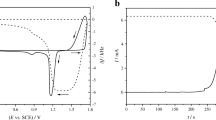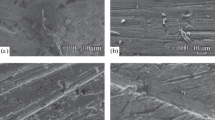Abstract
SEM and TEM observations of the corrosion layer obtained during the potentiostatic oxidation of lead electrodes in H2SO4 solution have shown that, at potentials above 1.00 V vs Hg/Hg2SO4, a lead dioxide layer is formed with crystal and gel-like (hydrated) structures. The crystal zones of the corrosion layer contain α- and β-PbO2 crystals. Applying controlled thermal degradation it has been established that hydrated zones (denoted as PbO(OH)2) comprise about 10% of the corrosion layer. For comparison, the lead dioxide active mass of the lead-acid battery is hydrated over 30%. On prolonged polarization of the lead dioxide electrode at 1.50 V, the basic electrochemical reaction that takes place is oxygen evolution. It has been suggested that this reaction occurs mainly at the interface crystal/gel-like zones. On opening the circuit, the electrode potential reaches the equilibrium potential for the PbO2/PbSO4 system within a rather long period. This potential decay is related to the diffusion of oxygen through the bulk of the corrosion layer (probably through its hydrated zones) to the solution and to the metal. A suggestion is made that hydrated zones are also involved in the oxygen reaction.
Similar content being viewed by others
References
D. Pavlov, C. N. Poulieff, K. Klaja and N. Iordanov, J. Mectrochem. Soc. 116 (1969) 316.
D. Pavlov and N. Iordanov, 117 (1970) 1103.
D. Pavlov, Electrochim. Acta 23 (1978) 845.
K. R. Bullock and M. A. Butler, J. Electrochem. Soc. 133 (1986) 1085.
D. Pavlov, I. Balkanov and P. Rachev, 137 (1987) 2390.
D. Pavlov and I. Balkanov, 139 (1992) 1830.
D. Pavlov, 139 (1992) 3075.
D. Pavlov and R. Popova, Electrochim. Acta 15 (1970) 1483.
P. Ruetschi, J. Electrochem. Soc. 120 (1973) 331.
P. Scherrer, Nachr. Ges. Wiss., Goettingen 98 (1918).
B. E. Warren and J. J. Biscoe, J. Am. Ceram. Soc. 21 (1938) 16.
Y. Amenomiya and R. C. Cvetanovic, J. Phys. Chem. 67 (144) (1963) 2046, 2705.
D Pavlov, I. Balkanov, T. Halachev and P. Rachev, J. Electrochem. Soc. 136 (1989) 3189.
P. Ruetschi, J. Ackerman and R. Amlie, 107 (1960) 325.
B. N. Kabanov, E. S. Weisberg, I. L. Romanova and E. V. Krivolapova, Electrochim. Acta 9 (1964) 1197.
Author information
Authors and Affiliations
Rights and permissions
About this article
Cite this article
Monahov, B., Pavlov, D. Hydrated structures in the anodic layer formed on lead electrodes in H2SO4 solution. J Appl Electrochem 23, 1244–1250 (1993). https://doi.org/10.1007/BF00234807
Received:
Revised:
Issue Date:
DOI: https://doi.org/10.1007/BF00234807




